The Moto G (2015) Review
by Brandon Chester on August 19, 2015 8:00 AM EST- Posted in
- Smartphones
- Mobile
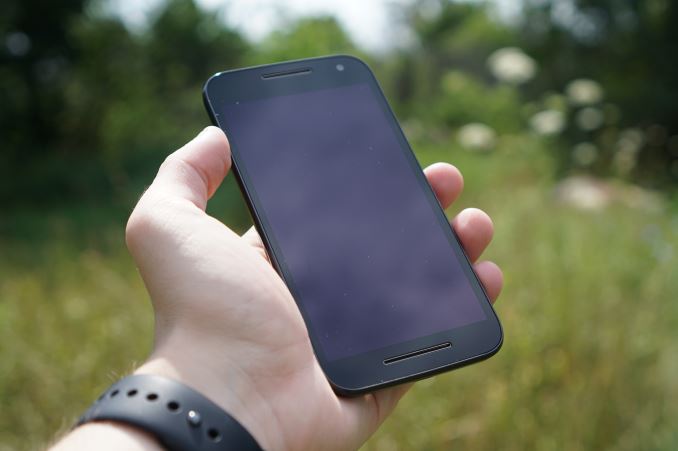
Motorola's original Moto G was one of the first Android devices to offer what one could honestly call a good user experience at a price of around $200. It had a 4.5" 720p display, Qualcomm's Snapdragon 400 SoC, a 5MP rear camera, 1GB of RAM, and 8GB of memory. Since that time, Motorola has adopted a structure where their Moto E fills in the sub $150 range, the Moto G hovers around $200, and the Moto X acts as a several hundred dollar flagship device, although the dual Moto X launch for 2015 changes this slightly. In early 2014 we saw Motorola refresh the Moto G with support for LTE, and later in the year they did a more major refresh which bumped the display size to 5", the camera resolution to 8MP, and added the microSD slot from the LTE model of the original version.
While Motorola's 2014 refresh of the Moto G was technically a major update as far as their yearly cadence was concerned, many aspects of the phone remained the same. There was no change to the SoC or the amount of RAM, no change to the display resolution or connectivity, and no change to battery capacity. The early 2015 launch of the Moto E made things even stranger, as it shipped with some specifications that actually outclassed the Moto G, such as Qualcomm's Snapdragon 410 SoC. This put Motorola in a strange situation, which has finally been resolved with the new 2015 model of the Moto G. In my view, this is the first truly major update that the phone has seen since the original version, and you can see what improvements Motorola has made in the chart below.
| Moto G (2014) | Moto G (2015) | |
| SoC | Snapdragon 400 1.2 GHZ A7 | Snapdragon 410 1.4 GHz A53 |
| RAM | 1GB | 1/2GB |
| NAND | 8GB NAND + microSD | 8/16GB NAND + microSD |
| Display | 5” 720p IPS |
5” 720p IPS |
| Network | 2G / 3G / 4G LTE | 2G / 3G / 4G LTE (Category 4 LTE) |
| Dimensions | 141.5 x 70.7 x 11mm, 149g | 142.1 x 72.4 x 6.1-11.6mm, 155g |
| Camera | 8MP Rear Facing (Sony IMX179) f/2.4, 1.4 micron 1/3.2" sensor | 13MP Rear Facing (Sony IMX214) f/2.0, 1.1 micron 1/3.06" sensor |
| 2MP Front Facing | 5MP Front Facing | |
| Battery | 2070 mAh (7.87 Whr) | 2470 mAh (9.39 Whr) |
| OS | Android 4.4 (At Launch) | Android 5.1 (At Launch) |
| Connectivity | 2.4 GHz 802.11b/g/n + BT 4.0, USB2.0, GPS/GNSS |
2.4 GHz 802.11b/g/n + BT 4.0, USB2.0, GPS/GNSS |
| SIM | MicroSIM | MicroSIM |
| Launch Price | $179 (1GB/8GB) | $179 (1GB/8GB) $219 (2GB/16GB) |
As you can see above, this year's iteration of the Moto G brings along some significant improvements. For the first time ever, we're seeing an update to the Moto G's SoC. While both the first and second generation models used Qualcomm's Snapdragon 400 SoC with four 1.2GHz Cortex A7 cores, this year's model adopts a 1.4GHz version of Snapdragon 410 with four Cortex A53 cores. The battery also receives a hefty bump in capacity, although this does come along with an increase in height, width, and thickness, as well as a slight increase in mass. Memory remains the same for the base model at 8GB of NAND and 1GB of RAM, but an extra $40 bumps that to 16GB of NAND and 2GB of RAM.
The rear-facing camera moves from Sony's IMX179 sensor to IMX214 which interestingly enough is the same improvement that was made going from the Nexus 5 to the Nexus 6. The sensor size increases from 1/3.2" to 1/3.06", and the resolution is bumped to 13MP from 8MP. This means that pixel size drops from 1.3 micron to 1.12, and low light scenarios may see a reduction in image quality as a result, but the wider F/2.0 aperture can help to offset this. The front-facing camera also jumps from a 2MP to a 5MP sensor.
Connectivity and the display don't see any improvements with this upgrade. We're still looking at a 5" 1280x720 IPS display, and with WiFi and Bluetooth you get 2.4GHz 802.11n and Bluetooth 4.0 LE.
Design
At this point, Motorola's industrial design is fairly well known and understood. All of their devices, from the Moto E all the way up to the Nexus 6, have essentially the same chassis shape with differing dimensions. The big difference between Motorola's devices is the materials that are used. While Moto Maker allows users to customize their devices to some extent, more expensive devices may have special options like wood back covers, and may have metal frames around the chassis rather than plastic ones. Being a mid-range smartphone, the Moto G is made primarily of plastic.
When it comes to the front face and sides the 2015 Moto G continues to share a design with Motorola's other devices. It has speakers sitting above and below the display, and a front facing camera sitting to the right of the upper speaker. The sides are flat on the edge that meets the display, and curved on the edge that meets the back cover. Both the power button and volume rocker are located on the right side of the phone, and the power button has the same texture to it as the Nexus 6 and Moto E, which makes it easy to tell apart from the volume rocker. Something that does concern me a bit about the sides of the device is the large gap between the back cover and the rest of the device. There are points where the gap is wide enough that you can feel it decreasing in size when you grip the phone in that area, which concerned me both because it negatively impacts the feel of the device, and because the Moto G is supposed to be waterproof.
The back of the 2015 Moto G is where things depart slightly from how Motorola devices usually look. On older Motorola devices, the rear-facing camera sat above a small indent which had the Motorola logo inside it. The camera flash either sat between the logo and the camera, or was integrated into the ring around the camera itself. All of these features were separate and sat flush with the back cover. The new Moto G and Motorola's recently launched Moto X devices now have a strip which connects the camera, flash, and Motorola logo and puts them slightly below the level of the back cover.
Since the Moto G can be customized with Moto Maker, there will potentially be differences between a consumer's device and the review unit I have. In my case, the Moto G's back cover is made of black plastic, with a series of raised diagonal lines which gives it a different feeling from a device with a smooth back like the Moto E. I personally prefer the in hand feel of this back cover to the smooth slippery plastic on the Moto E, and I think the black color goes very well with it.
As I mentioned earlier, the Moto G is waterproof. Its IPX7 rating specifies that it can be submerged up to 1 meter deep for up to thirty minutes. While I didn't push the device to that limit just due to worries about possibly damaging a review unit, I did put it under thirty centimeters of water for around twenty minutes and it did not sustain any damage. All back covers for the third generation Moto G have plastic sections that fit into and protect the open ports on the back of the phone from any water getting in. While there was absolutely no damage, you can see above that water was able to get between the back of the chassis and the back cover even though I made sure to secure the back cover tightly and properly. I don't believe this to be any cause for concern, but I felt it was worth sharing. With a removable back cover this issue can't really be avoided, and the inserts that block important ports have kept water out of the areas that need to be protected.
In the end I think the 2015 Moto G has a good feel in the hand, and I think the build quality is more than acceptable for a phone that starts at $179. I definitely prefer the textured back cover to the smooth and slippery ones on some other Motorola phones, and if you're given that option I would definitely opt for it. My only complaint is that the back cover doesn't attach as tightly to the phone as I would like, and you can notice the gap when you touch it at the edges. The gap also seems to be big enough to let water through, but the protective covers on the back cover ensure that the phone won't get damaged.


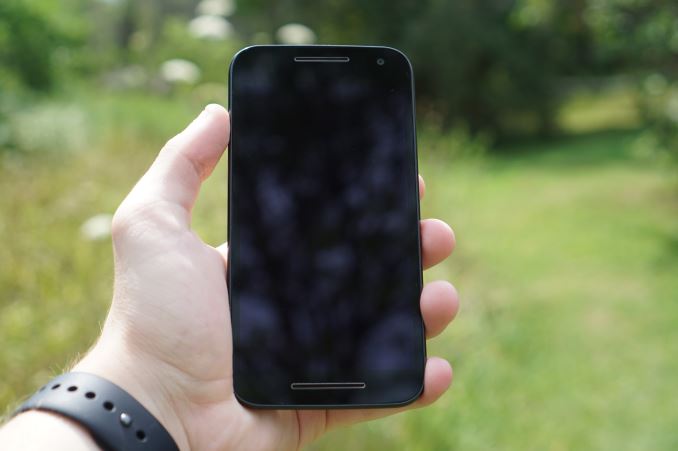
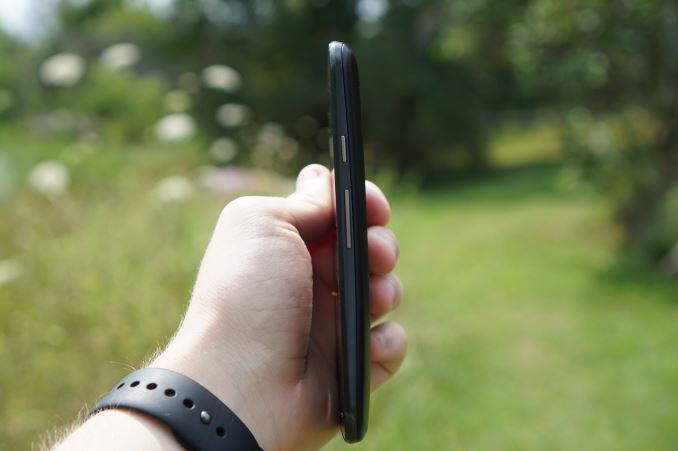
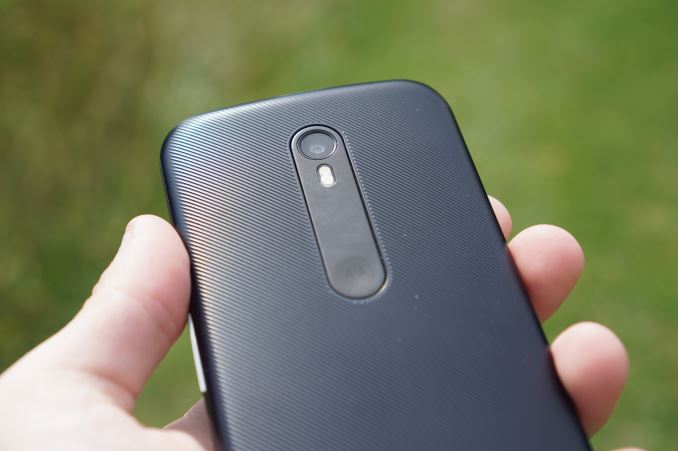
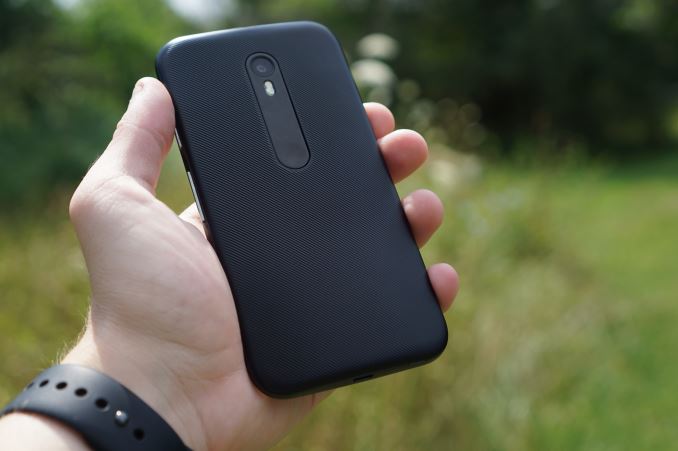
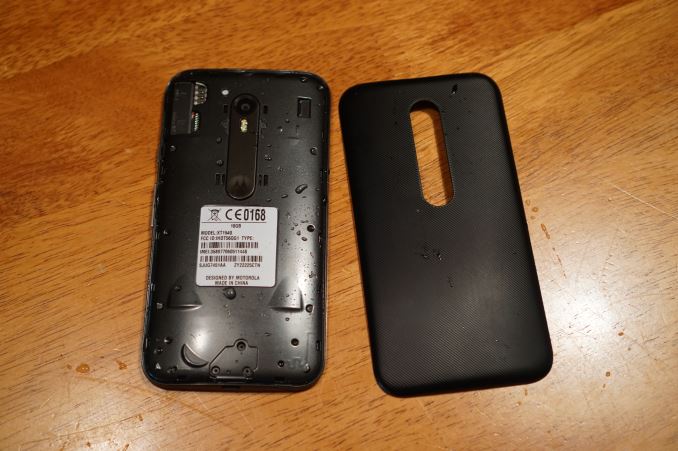








90 Comments
View All Comments
kmmatney - Wednesday, August 19, 2015 - link
They are in the $115 - $130 range on Swappa (at least the Sprint version). Of course that is used - but the phones I've bought from Swappa all looked brand-new when I received them. You can also get a used Galaxy S4 for ~$130, and will come with 2 GB of RAM and 16GB of storgae, and will be faster.Moto1 - Wednesday, August 19, 2015 - link
Nope, sorryamdwilliam1985 - Thursday, August 20, 2015 - link
Moto G 2015 will probably beat Galaxy S6 and Note 5 in general phone usage speed test, lol. So Galaxy S4 is probably not a good comparison to.3DoubleD - Wednesday, August 19, 2015 - link
It is not clear in the charging section whether the Moto G is limited to 2.75 W charging internally, or whether it is because a 2.75 W charger was used (because it was shipped with one). Could one conceivably use a 5 W or 10 W charger and cut the charge time in half or a quarter? This is not clear. I honestly didn't know they made 2.75 W chargers, the smallest charger I've ever seen is 1 A @ 5 V.Also, how crippling is this GPU performance? From what I can tell, an Adreno 305 is about 1/4 of the speed of the Nexus 5 (2013) in offscreen testing with Basemark X. But this doesn't describe the context of what it is like to use an Adreno 306 device. Does the UI studder? Does video playback work flawlessly? Does it play most games? Are there any notable games it does not play?
Also, I take issue with the comment that waterproofing is not a desirable feature because you can't use the display while wet. That is an insane comment to make! Most people would like some piece of mind that if their phone gets a little wet it won't become an expensive paper weight. That is a huge feature, especially considering the target market for this phone - a group that may likely be careless with their phone that it needs to be inexpensive and waterproof. So I'll say this in the comments since it wasn't said in the review: Motorola, good job making this phone waterproof.
Lastly, I don't think Motorola was praised enough for adding a bigger battery at the cost of not decreasing the thinness of the device. Phone manufacturers frequently shift the balance the wrong way, and finally Motorola stepped up and did it right.
Despite all of my question and critiques, I really appreciate the timely review! Thanks!
hans_ober - Wednesday, August 19, 2015 - link
Yeah, nice to see Moto worked on the battery and didn't go for 'omg 7mm slim' type of device.Thick phone > dead slim paperweight.
Brandon Chester - Wednesday, August 19, 2015 - link
1. It's just that the phone is shipped with a 2.75W charger. I will be listing a charge time using a 5W charging block, but to my knowledge there's no quick charge support so there's no additional advantage to using an even higher wattage QC 2.0 block2. You can play 2D games and very simple 3D ones like temple run, but there's not much hope for what one would call AAA mobile games. My big issue is the lack of GPU performance in mid range Android devices ends up limiting the availability and quality of those games on Android as a whole.
3. At no point did I ever say that waterproofing was not a desirable feature, or anything of that sort. I said it's nice to have, but I don't think it's a selling point. There's no evidence that any significant number of consumers are buying devices specifically because they're waterproof, so I don't think my observation was incorrect.
4. Not everyone shares the opinion that devices should get substantially larger to fit bigger batteries.
hans_ober - Wednesday, August 19, 2015 - link
Thanks. Yeah, theres no QC 2.0 support, but using 5W and even 10W chargers has reportedly cut short charging time. No harm in adding QC 2.0 to the graph too; it will show max possible charge rate, with the phone as bottleneck.Brandon Chester - Wednesday, August 19, 2015 - link
I'm just trying to kill the phone's battery now so I can charge it.hans_ober - Wednesday, August 19, 2015 - link
Having a bad time? :)hans_ober - Tuesday, August 25, 2015 - link
Update on charging time?